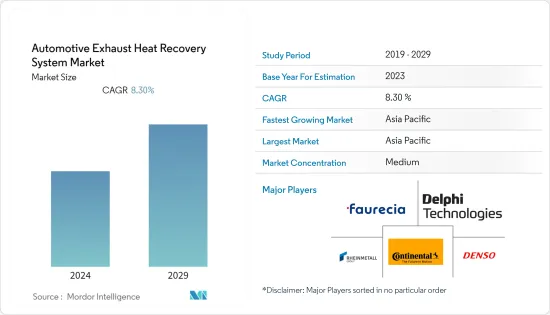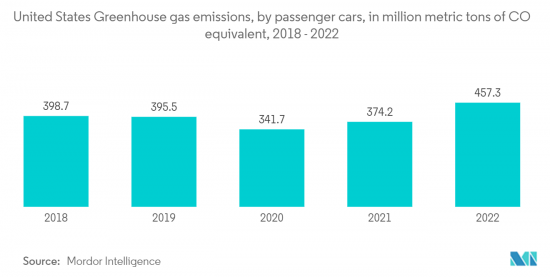 |
市場調査レポート
商品コード
1406129
自動車用排熱回収システム:市場シェア分析、産業動向・統計、成長予測、2024年~2029年Automotive Exhaust Heat Recovery System - Market Share Analysis, Industry Trends & Statistics, Growth Forecasts 2024 - 2029 |
||||||
● お客様のご希望に応じて、既存データの加工や未掲載情報(例:国別セグメント)の追加などの対応が可能です。 詳細はお問い合わせください。
| 自動車用排熱回収システム:市場シェア分析、産業動向・統計、成長予測、2024年~2029年 |
|
出版日: 2024年01月04日
発行: Mordor Intelligence
ページ情報: 英文 90 Pages
納期: 2~3営業日
|
- 全表示
- 概要
- 目次
自動車用排熱回収システム市場の現在の市場規模は237億米ドルと推定されます。
予測期間中にCAGR 8.3%を記録し、予測期間終了時には354億米ドルに達すると予想されます。

自動車用排熱回収システム市場は、自動車産業の中で急速に発展している分野です。自動車の排気システムから発生する廃熱を利用・活用し、全体的な効率を高め、排出ガスを削減し、燃費を向上させることに焦点を当てています。この技術は、環境問題、排出規制の強化、燃費向上の継続的な追求により、大きな注目と重要性を獲得しました。
排ガス規制の強化により、自動車メーカーは燃焼を最適化し、有害な排出ガスを削減する必要に迫られているため、排熱回収システムの採用は世界的に増加傾向にあります。さらに、耐熱合金やセラミックのような先端材料の開発により、これらの部品の効率と耐久性が向上しています。
自動車用排熱回収システム市場のもう一つの主要促進要因は、乗用車と商用車の販売です。乗用車の販売台数が2021年の5,640万米ドルから2022年には5,740万米ドルに増加することが、自動車用排熱回収システム市場の成長に寄与しています。
自動車用排熱回収システム市場の動向
厳しい排ガス規制が市場成長を牽引
2023年4月、環境保護庁(EPA)は、小型車および中型車からの有害な大気汚染物質の排出をさらに削減することを目的とした基準の更新を明らかにしました。この提案は、2023年から2026年までの乗用車と小型トラックに対するEPAの連邦温室効果ガス排出基準に基づいています。クリーンカー技術の進歩を活用し、米国民にさまざまな恩恵をもたらすものです。これには、気候汚染の削減、公衆衛生の向上、燃料費やメンテナンス費用の削減による 促進要因のコスト削減などが含まれます。
提案されている基準では、自動車メーカーは燃焼をさらに最適化し、排出ガスを大幅に削減することが求められると予想されます。このような厳しい基準を満たすために、自動車メーカーは排熱回収システム(EHRS)を採用する可能性が高まっています。これは、廃熱を回収してエンジン全体の効率を向上させ、最終的に排出ガスの低減につなげる効果的な技術です。
これらの基準の一環として、燃費の改善が重視されています。EHRSは、排熱を回収・利用して有用な作業を行い、自動車の燃料消費量を削減することで、より良い燃費を達成する上で重要な役割を果たすことができます。

アジア太平洋地域が最も急成長する見込み
2022年には、アジア太平洋地域が世界の自動車販売台数の58%と大半を占め、自動車業界の急速な技術革新による需要の大幅な急増を反映しています。
アジア太平洋地域は世界人口の60%近くを占めており、予測期間中、自動車需要は同地域で最も高くなると予想されます。また、同地域では政府の規制が厳しくなっています。例えば、インド政府は自動車から排出される汚染物質を規制するため、BS-VI基準を制定しています。排熱回収システムは、自動車から排出される汚染物質の割合を減らすだけでなく、自動車の燃費を向上させるためです。地域の汚染レベルが高まるにつれ、人々の環境に対する意識は高まり、購入する自動車からの排出ガスに対する関心も高まっています。
中国における排ガス規制の急速な進展と強化により、メーカーは現行の中国6a排ガス規制を遵守するため、粒子状物質と窒素酸化物の排出量をさらに持続的に削減する必要に迫られています。このため、オンハイウェイおよびオフハイウェイ部門の商用車には、排ガス再循環対策の追加が義務付けられています。
自動車用排熱回収システム産業概要
自動車用排熱回収システムは、集中的な研究開発活動、新製品開発、買収などの様々な戦略により、市場に複数のメーカーが存在するため、断片化された競合市場です。
- 2022年8月、ボッシュはSLM500を2台買収し、積層造形分野への進出を大きく後押ししました。この戦略的投資は、3Dプリンティング技術を採用するボッシュの能力を強化することで、自動車産業をさらに推進します。
- 2023年1月、ゼネラルモーターズは、V8ガソリンエンジンの生産を強化するため、米国の4工場に9億1,800万米ドルを投資すると発表しました。
その他の特典:
- エクセル形式の市場予測(ME)シート
- 3ヶ月間のアナリストサポート
目次
第1章 イントロダクション
- 調査の前提条件
- 調査範囲
第2章 調査手法
第3章 エグゼクティブサマリー
第4章 市場力学
- 市場促進要因
- 市場抑制要因
- ポーターのファイブフォース分析
- 供給企業の交渉力
- 買い手・消費者の交渉力
- 新規参入業者の脅威
- 代替品の脅威
- 競争企業間の敵対関係の強さ
第5章 市場セグメンテーション
- 技術
- 排気ガス再循環(EGR)
- ターボチャージャー
- 車両タイプ
- 乗用車
- 商用車
- 地域
- 北米
- 米国
- カナダ
- その他北米
- 欧州
- ドイツ
- 英国
- フランス
- その他欧州
- アジア太平洋
- インド
- 中国
- 日本
- 韓国
- その他アジア太平洋地域
- その他の地域
- ブラジル
- アラブ首長国連邦
- その他
- 北米
第6章 競合情勢
- ベンダー市場シェア
- 企業プロファイル
- Delphi Technologies
- Valeo Service
- Denso
- Faurecia
- Mahle
- Rheinmetall Automotive
- Mitsubishi Electric
- Calsonic Kansai
- Continental AG
- Borgwarner
第7章 市場機会と今後の動向

The Automotive Exhaust Heat Recovery market is estimated to be valued at USD 23.7 billion in the current year. It is expected to reach USD 35.4 billion by the end of the forecast period, registering a CAGR of 8.3% during the forecast period.
The Automotive exhaust heat recovery market is a rapidly evolving sector within the automotive industry. It focuses on harnessing and utilizing waste heat generated by a vehicle's exhaust system to enhance overall efficiency, reduce emissions, and improve fuel economy. This technology gained significant attention and importance due to environmental concerns, stricter emission regulations, and the continuous quest for improved fuel efficiency.
The adoption of exhaust heat recovery systems is on the rise globally as stricter emission standards push automakers to optimize combustion and reduce harmful emissions. Furthermore, the development of advanced materials, like heat-resistant alloys and ceramics, is enhancing the efficiency and durability of these components. Also, governments and regulatory bodies incentivize automakers through credits for adopting fuel-saving technologies, including exhaust heat recovery systems.
Another major driver for the Automotive Exhaust Heat recovery systems market is the sales of passenger cars and commercial vehicles. The increase in passenger car sales from USD 56.4 million in 2021 to USD 57.4 million in 2022 is contributing to the growth of the automotive exhaust heat recovery market.
Automotive Exhaust Heat Recovery System Market Trends
Strict Emission Regulations Driving the Market Growth
In April 2023, the Environmental Protection Agency (EPA) revealed updated standards aimed at further decreasing harmful air pollutant emissions from light-duty and medium-duty vehicles, with the initial implementation set for model year 2027. This proposal is built upon EPA's previous federal greenhouse gas emissions standards for passenger cars and light trucks covering model years 2023 through 2026. It harnesses the advancements in clean car technology to deliver a range of benefits to the American population. It includes reduced climate pollution, enhanced public health, and cost savings for drivers due to reduced fuel and maintenance expenses.
The proposed standards are expected to require automakers to further optimize combustion and reduce emissions significantly. To meet these stringent standards, automakers may increasingly turn to exhaust heat recovery systems (EHRS). It is an effective technology to recover waste heat and improve overall engine efficiency, ultimately leading to lower emissions.
As part of these standards, there is an emphasis on improving fuel economy. EHRS can play a crucial role in achieving better fuel efficiency by capturing and utilizing exhaust heat to perform useful work, thus reducing the fuel consumption of vehicles.

Asia-Pacific is Expected to be the fastest growing region
In 2022, Asia-Pacific accounted for the majority of global vehicle sales at 58%, reflecting a significant surge in demand owing to rapid technological innovations in the automotive industry.
Asia-Pacific accounts for almost 60 % of the world's population, and the demand for vehicles is expected to be the highest in the region for the forecasted period. Also, government regulations are becoming strict in the region. For example, BS-VI standards are enforced by Govt. of India to regulate the expelled pollutants from motor vehicles. With the addition of environmental norms, exhaust heat recovery systems will be more in demand as these systems not only reduce the percentage of pollutants coming out from the vehicles but also increase the fuel efficiency of the vehicle. With the growing pollution levels in the region, people are becoming more aware of the environment and more concerned about the emissions from the cars they purchase.
The rapidly progressing and tightening of exhaust emission standards in China is forcing manufacturers to achieve a further sustained reduction in particulate and nitrogen oxide emissions in order to comply with the current Chinese 6a emissions standard. Additional exhaust-gas recirculation measures are thus mandatory for commercial vehicles in the on and off-highway sector.
Automotive Exhaust Heat Recovery System Industry Overview
Key exhaust heat recovery system participants are Continental AG, Delphi Technologies, Denso, Faurecia, Rheinmetall Automotive, and others. The automotive exhaust heat recovery system is a fragmented and competitive market due to the presence of several manufacturers in the market, owing to various strategies such as focused research and development activities, new product developments, acquisitions, etc. For instance,
- In August 2022, Bosch acquired two SLM500s, a move that significantly boosted its expansion into the additive manufacturing sector. This strategic investment further propels the automotive industry by strengthening Bosch's capabilities in adopting 3D printing technologies.
- In January 2023, General Motors announced a substantial investment of USD 918 million across four US plants to bolster the production of V8 gasoline engines.
Additional Benefits:
- The market estimate (ME) sheet in Excel format
- 3 months of analyst support
TABLE OF CONTENTS
1 INTRODUCTION
- 1.1 Study Assumptions
- 1.2 Scope of the Study
2 RESEARCH METHODOLOGY
3 EXECUTIVE SUMMARY
4 MARKET DYNAMICS
- 4.1 Market Drivers
- 4.2 Market Restraints
- 4.3 Porter's Five Forces Analysis
- 4.3.1 Bargaining Power of Suppliers
- 4.3.2 Bargaining Power of Buyers/Consumers
- 4.3.3 Threat of New Entrants
- 4.3.4 Threat of Substitute Products
- 4.3.5 Intensity of Competitive Rivalry
5 MARKET SEGMENTATION
- 5.1 Technology
- 5.1.1 Exhaust Gas Recirculation (EGR)
- 5.1.2 Turbocharger
- 5.2 Vehicle Type
- 5.2.1 Passenger Car
- 5.2.2 Commercial Vehicle
- 5.3 Geography
- 5.3.1 North America
- 5.3.1.1 United States
- 5.3.1.2 Canada
- 5.3.1.3 Rest of North America
- 5.3.2 Europe
- 5.3.2.1 Germany
- 5.3.2.2 United Kingdom
- 5.3.2.3 France
- 5.3.2.4 Rest of Europe
- 5.3.3 Asia-Pacific
- 5.3.3.1 India
- 5.3.3.2 China
- 5.3.3.3 Japan
- 5.3.3.4 South Korea
- 5.3.3.5 Rest of Asia-Pacific
- 5.3.4 Rest of the World
- 5.3.4.1 Brazil
- 5.3.4.2 United Arab Emirates
- 5.3.4.3 Other Countries
- 5.3.1 North America
6 COMPETITIVE LANDSCAPE
- 6.1 Vendor Market Share
- 6.2 Company Profiles
- 6.2.1 Delphi Technologies
- 6.2.2 Valeo Service
- 6.2.3 Denso
- 6.2.4 Faurecia
- 6.2.5 Mahle
- 6.2.6 Rheinmetall Automotive
- 6.2.7 Mitsubishi Electric
- 6.2.8 Calsonic Kansai
- 6.2.9 Continental AG
- 6.2.10 Borgwarner
